(UroToday.com) Dr. Monique Roobol, one of the session chairs, kicked off the update session with a summary of the current state of PSA screening in Europe followed by the recently published recommended screening algorithm by the EAU. This algorithm has recently been published and the reference can be found below.1
To start off, she summarized the current incidence and mortality of prostate cancer in Europe relative to other malignancies. This is seen in the pie chart below. Prostate cancer remains a significant source of cancer incidence in Europe and mortality.

However unlike other malignancies such as colorectal cancer and lung cancer which have implemented Europe-wide screening programs and are part of Europe Beating Cancer Plan, prostate cancer screening has not yet been standardized at the European level nor has it received the recognition it deserves.
Based on the current knowledge of prostate cancer screening, Dr. Roobol and other experts in Europe have developed in individually and geographically tailored cancer screening algorithms which is unique in the cancer screening arena. The publication by Van Poppel at al.1 is an important first step to the authors’ aim of replacing opportunistic heterogeneous subjective and potentially harmful screening practices with the eventual goal of a Europewide population based program.
The flow chart below summarizes the multiple risk stratification steps that are incorporated in their screening program.

Based on their data, only approximately 10% of men 50-59 years old and 25% of men 60-70 years old would move on to risk stratification. The risk stratification incorporates PSA density (into low and high risk initially) and mpMRI at this point but has room to include additional markers (genomic, genetic, etc.).
PSA density alone results in 30% fewer referrals for MRI and prostate biopsy.
Their overarching goals for European wide programs include the following:
1) by 2024, the European Commission should have developed new guidelines on risk stratified screening of prostate cancer
2) by 2026, at least five EU member state will have incorporated these guidelines into their national Cancer plans
3) 50% immediate reduction of overdiagnosis and overtreatment in those countries aligned with EU risk stratified guidelines
4) by 2027, all EU member states have a clear strategy for risk stratified early detection of prostate cancer in all men turning 50 years old
Written by: Thenappan (Thenu) Chandrasekar, MD – Urologic Oncologist, Assistant Professor of Urology, Sidney Kimmel Cancer Center, Thomas Jefferson University, @tchandra_uromd on Twitter during the 2021 European Association of Urology, EAU 2021- Virtual Meeting, July 8-12, 2021.
References:


